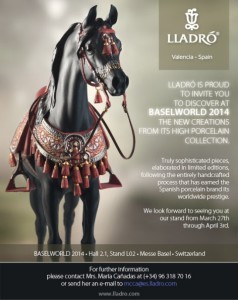With the opening of two new pop-up stores in India, both in New Delhi: Palladium Mall and Select City Walk, it is good to remember that Lladró is one of Valencia’s most international companies.
Valencia is not only world famous for its paella, Fallas, and its football club, it is also the home of Lladró, the prestigious porcelain company, which is a household name even in Hollywood, where Lladró’s distinctive pieces are frequently featured in the world of entertainment.
One example is in the popular TV series ‘Will and Grace’. In one episode Will’s mother had a collection of Lladrós, her favourite being ‘Ouisan, the bashful geisha’, which she describes as being “priceless”. When Grace breaks it, she tries to shift the blame onto others, creating various comical situations.
The massive popularity of Will and Grace is seen not only among the public, but is manifested in the number of stars who make long-term or one-off cameo appearances.
Debbie Reynolds, Alan Arkin, Geena Davis, Sydney Pollack and Minnie Driver have all had considerable but secondary roles as relatives of the main stars, as have Harry Connick, Jr, Woody Harrelson and Gregory Hines.
Other big stars to appear, as themselves or as zany characters are Beau Bridges, Edward Burns, John Cleese, Jeff Goldblum, Alec Baldwin, Gene Wilder, Jack Black, Richard Chamberlain, Glenn Close, Joan Collins, Macaulay Culkin, Matt Damon, Michael Douglas, Andy Garcia, Stacy Keach, Madonna, Demi Moore, Britney Spears, Sharon Stone, Kevin Bacon, Candice Bergen, Cher, Deborah Harry, Janet Jackson, Elton John, James Earl Jones, Jennifer Lopez, Barry Manilow and Martina Navratilova.
The Lladró story (the real one) began in the village of Almàssera, just north of Valencia in 1953, when brothers Juan, José and Vicente Lladró made their first creations in a Moorish furnace built in their own home. Over a period of years they then developed their own ideas parallel to working in a local tile and crockery factory.
By 1955 they had begun making sculptures reflecting the style of XVIII century trends, influenced by international porcelain artists such as Meissen, Sèvres and Capodimonte.
In 1958 they set up their own premises in nearby Tavernes Blanques, where they introduced innovations not only in the design and style of their pieces but also in the firing techniques, reducing the three-layer firing to a one-layer process. They began to employ a growing number of sculptors, chemists and decorators, increasing the production of their work and incorporating a logo on all their figurines, the Greek master piece, the Victory of Samotracia.
In 1962 the brothers opened the Professional Training School to develop local artistic talent. Many famous Fallas artists began their training there.
They started opening shops in Valencia in the 60s and when a group of Americans discovered the brothers’ creations on a trip to Valencia looking for new products to import into their country, the process of internationalisation had begun.
In 1965, Lladró began to export to Canada and the United States, where the brothers travelled for the first time in 1969.
The 1970s were marked by Lladró’s consolidation in the American market. The logotype changed due to a desire to establish an association between science and art, the basis of creation in porcelain; the new logo arising as a result of the union between an ancient chemical symbol and the stylised version of a local Valencian bell-shaped flower.
In the 1980s the second Lladró generation, represented by Rosa, Mamen and Juan Vicente Lladró underwent long apprenticeships before assuming responsibility in the company, including the tasks of the creativity committee. In 1986, the company signed a joint-venture agreement with the Mitsui group, a figurine dealer in Japan and, then developed outlets in China, Australia and the United Kingdom. On September 18th 1986 the Lladró Museum was opened in New York on 57th street in Manhattan.
In 1985, the Lladró Collectors Society was created, bringing together more than one hundred thousand lovers of art in fine porcelain.
In 1991, the Hermitage Museum of Saint Petersburg became the venue of an exhibition of Lladró sculptures. Later, Lladró exhibited a selection of its emblematic pieces in the Valencia Pavilion in the Universal Show of Seville, as well as in the Museum of Modern Art of Santo Domingo.
During this decade, Lladró continued expanding in some of the world’s most important cities. In 1996, the Lladró Centre in Beverly Hills was opened.
Finally, after fifty years at the head of the company, the three founding brothers turned over control to the second Lladró generation, which became part of the new Board of Directors in 2003.
Into the 21st century Lladró has diversified its range of products, undertaking collaborations in the bathroom fittings and jewellery sectors.
Lladró creates all its figurines in the City of Porcelain, a complex with bright studios and workshops that also has sports facilities and spacious gardens. Located in Tavernes Blanques and opened in 1969, it now covers an area of 100,000 square feet. Every year over 15,000 people visit the complex.
Apart from Will and Grace, in ‘The Sopranos’, Carmela Soprano boasts about her Lladró figurine in one episode and breaks it by throwing it at Tony Soprano in another.
In ‘The Nanny’ Fran’s paternal aunt Freida wonders whether or not to hire Niles as a butler. She decides to do so because she wants someone to dust her Lladró collection.
Whether in Tavernes Blanques, Valencia or in Hollywood, California, Lladró is undoubtedly an example of the creativity and vision that this beautiful little corner of Spain offers to the rest of the world.
In the summer of 2020 Lladró opened a boutique in SKP, Pekng’s most luxurious shopping centre.

